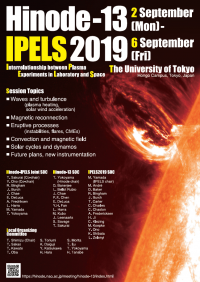›Fundamental Plasma Processes in the Sun, Interplanetary Space, and in the Laboratory
The solar atmosphere is filled with various types of heating and dynamic phenomena. These include the dynamo mechanism that creates the magnetic field, magneto-convection and MHD waves that transport energy via magnetic fields, MHD instabilities that result in large-scale explosions like flares and CMEs, and magnetic reconnection that transiently dissipates magnetic energy. All of these are physical mechanisms that work ubiquitously in the universe, and they have all been extensively studied in laboratory experiments and theoretical investigations.
Recent space-borne observatories such as Hinode, SDO, and IRIS have been providing high spatial resolution observations of dynamics in the solar atmosphere. New advanced facilities will also start their observations in the coming years. The 4-m aperture DKIST will have first light in 2019. Parker Solar Probe has just been launched, and together with Solar Orbiter, to be launched in 2020, will investigate plasma in the solar atmosphere by making a close approach to the Sun.
At the dawn of this new era, it is important to review recent observations by Hinode, SDO, IRIS and all other observatories, recent progress in space and laboratory plasma physics, and to have stimulating discussions on the future direction of laboratory and space plasma research.
Track this event on your Apple calendar














 Japan
Japan